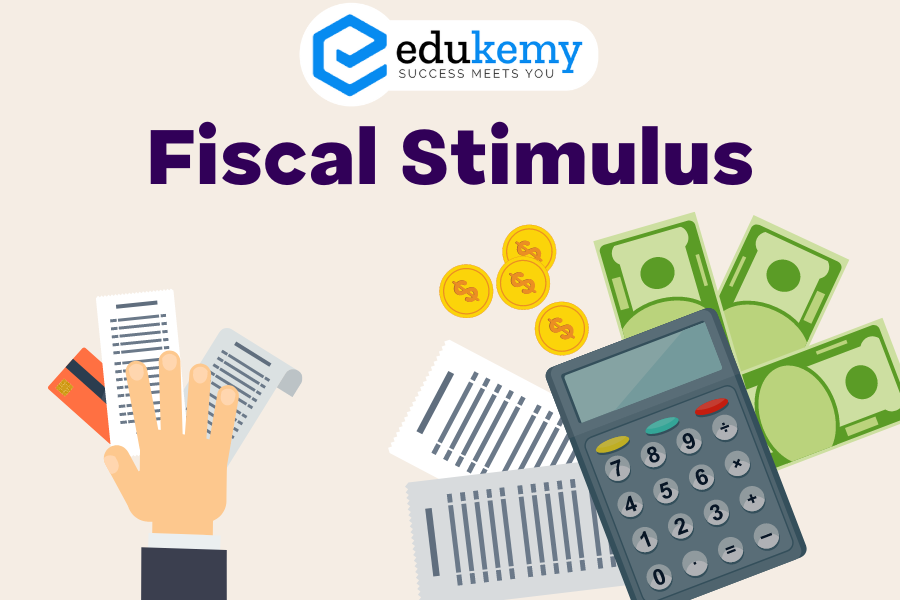
During periods of economic downturn or crisis, fiscal stimulus becomes a crucial tool for governments to boost economic activity. This approach, rooted in Keynesian economics, involves increased government spending and tax relief measures to stimulate demand and counter the negative impacts of a recession.
Contents
2008 Global Recession:
- Challenges Faced:
- In 2008, India faced the repercussions of a global recession. Tax revenues dwindled, demand slumped, and the corporate sector deferred investments, posing a threat to employment.
- Keynesian Solution:
- The government, adopting a Keynesian approach, implemented a fiscal stimulus package to counter the economic slowdown. This involved deviating from Fiscal Responsibility and Budget Management (FRBM) limits to allow for higher borrowing and spending.
- Fiscal Measures:
- Higher Deficit and Spending: The government increased fiscal deficit to facilitate higher spending, injecting funds into the economy.
- Tax Reliefs: Both direct and indirect tax reliefs were introduced to incentivize spending and support businesses.
- Monetary Measures:
- Simultaneously, monetary stimulus measures were implemented:
- Rate Cuts: Reduction in interest rates to encourage borrowing and spending.
- SLR (Statutory Liquidity Ratio) and CRR (Cash Reserve Ratio) Cuts: Lowering these ratios to infuse liquidity into the banking system.
- Simultaneously, monetary stimulus measures were implemented:
- Impact and Recovery:
- The combined fiscal and monetary stimulus was effective in preventing a prolonged economic slowdown. The growth rate rebounded to 8.4% in the fiscal years 2009-10 and 2010-11.
Challenges of Sustaining High Fiscal Deficit:
- Unsustainable Levels:
- While the fiscal stimulus provided a timely boost, maintaining a high fiscal deficit in the long term was deemed unsustainable.
- Rollback to Normal Levels:
- Beginning in 2010-11, a calibrated approach was adopted to roll back fiscal deficit levels to adhere to normal benchmarks.
2020 Global Pandemic:
- Lockdown Impact:
- In 2020, the global pandemic necessitated another departure from FRBM limits. The lockdowns severely impacted economic activity, prompting the government to resort to fiscal measures to support businesses and individuals.
Conclusion: Fiscal stimulus, though effective in managing economic crises, requires a balance. While it provides short-term relief, sustained high fiscal deficit poses challenges. Governments must carefully calibrate their fiscal policies, ensuring a return to normalcy once the immediate crisis is mitigated. The 2008 and 2020 instances illustrate the pragmatic use of fiscal stimulus to navigate economic challenges.
FAQs
Q: What is fiscal stimulus?
A: Fiscal stimulus refers to the government’s use of taxation and spending policies to boost economic activity during periods of economic downturn or recession. It typically involves increasing government spending and/or reducing taxes to stimulate demand and encourage consumer and business spending.
Q: How does fiscal stimulus work?
A: Fiscal stimulus works by injecting additional funds into the economy, either through government spending on infrastructure projects, healthcare, education, or other programs, or by reducing taxes on individuals and businesses. This extra money in circulation stimulates consumer spending, encourages investment, and helps to create jobs, ultimately aiding in economic recovery.
Q: What are the potential benefits of fiscal stimulus?
A: Fiscal stimulus can help mitigate the negative effects of a recession by boosting aggregate demand, preventing widespread unemployment, and supporting economic growth. It can also help stabilize financial markets and restore confidence among consumers and businesses, leading to increased investment and productivity in the long run.
Q: What are the drawbacks or risks associated with fiscal stimulus?
A: One potential drawback of fiscal stimulus is the risk of increasing government debt and budget deficits, which could lead to higher inflation, interest rates, and crowding out private investment in the future. Moreover, if the stimulus measures are not targeted effectively or if there are delays in implementation, they may not achieve the desired economic outcomes and could result in wasted resources.
Q: How does fiscal stimulus differ from monetary stimulus?
A: Fiscal stimulus involves direct government intervention through changes in taxation and spending policies, while monetary stimulus involves central banks adjusting interest rates, purchasing financial assets, or implementing other monetary policy measures to influence borrowing costs and money supply. While both fiscal and monetary stimulus aim to stimulate economic activity, they operate through different channels and have different impacts on the economy.
In case you still have your doubts, contact us on 9811333901.
For UPSC Prelims Resources, Click here
For Daily Updates and Study Material:
Join our Telegram Channel – Edukemy for IAS
- 1. Learn through Videos – here
- 2. Be Exam Ready by Practicing Daily MCQs – here
- 3. Daily Newsletter – Get all your Current Affairs Covered – here
- 4. Mains Answer Writing Practice – here

